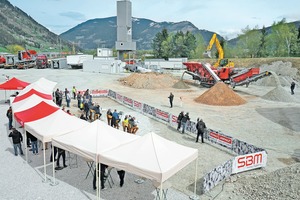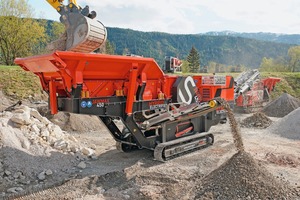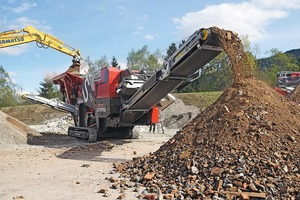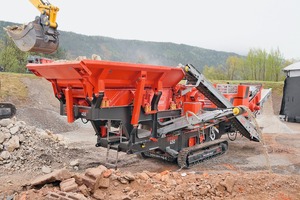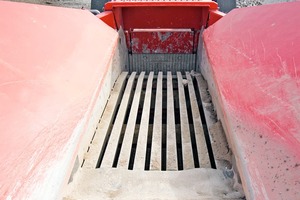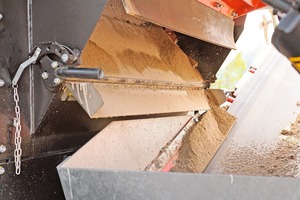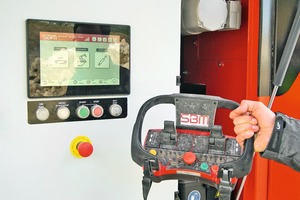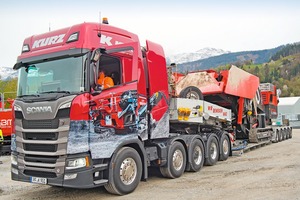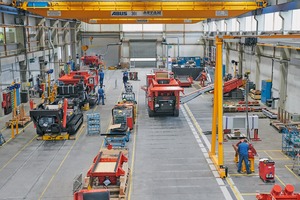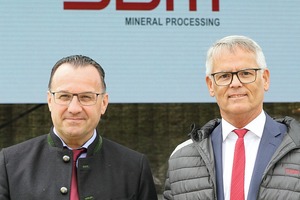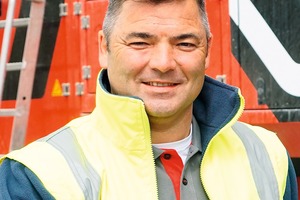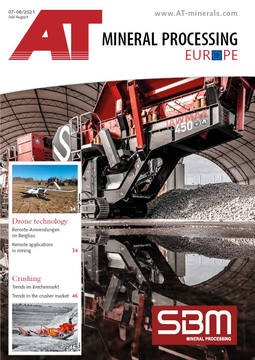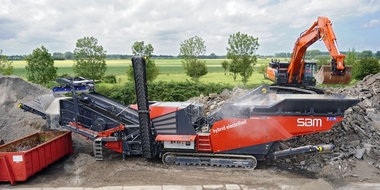SBM presents new crushing plants
After the presentation of the compact 27-tonne JAWMAX 200 last autumn at the same site, SBM again invited to the MFL Group’s approximately 22-hectare main plant. In addition to the foundry, mechanical engineering departments and production facilities of the sister companies Maschinenfabrik Liezen and the grinding specialist Christian Pfeiffer Maschinenfabrik, the large plant also comprises the assembly lines for the crushing and concrete mixing technology of SBM Mineral Processing. The headquarters and development center of the company are located in Oberweis near Gmunden.
The extensive testing area at the Liezen plant offered plenty of space for an almost complete presentation of the SBM programme of track-mounted jaw and impact crushers, which has meanwhile been expanded to a total of ten standard models with operating weights between 30 and 60 tonnes. Also on display were various semi-stationary processing solutions and the company’s successful concrete mixing technology. However, the focus was on performance-oriented demonstrations of the fundamentally redesigned JAWMAX 400/450 series and the REMAX 450 impact crusher, based on the REMAX 400 model already introduced in 2018. The common feature of both new “450s” is a high-performance pre-screening unit that effectively separates contaminated or valuable material, thus reducing crusher wear while noticeably improving the crushing result in terms of quality and output. The new double-deck pre-screen is designed as a circular vibratory screen and is directly connected to the vibrating chute in the feed hopper. Via a triple flap on the screen run, the two fractions can be discharged in full or in part as fines or added to the end product as crusher bypass. Compared to the double-deck grizzly feeders of the 400 models, the pre-screen increases the hourly capacity by about 50 t/h to a maximum of 450 t/h, which positions both the 49.2 t REMAX 450 with the large “1300” impact crusher and optional secondary screen, and the JAWMAX 450 at the top of their respective performance classes.
Completely new design
According to the experts present, the new JAWMAX 400/450 are in a league of their own anyway. Like all SBM mobile crushers, both models have a diesel-electric/fully electric drive with an optional mains connection. The drive unit consists of a 6.7 l Cummins diesel (170 kW at 1500 rpm) in the current EU-V generation and a 200 kVa on-board generator feeding all electrical drives (feeders, screens, conveyor belts, etc.) as well as the electrically operated hydraulics for the lifting cylinders and tracks.
Via a V-belt, a 110 kW electric motor drives the new STE 110-70 jaw crusher, specially developed by SBM for mobile application. As one of the largest crushers in the 40-tonne class, the 14.35-tonnes unit offers an inlet opening of 1100 mm x 700 mm. The nominal feed material size of 0 – 700 mm, a max. lump size of 1000 x 600 x 600 mm and the design for rock strengths of up to 400 MPa enable a very wide range of applications, from the processing of large-sized concrete residues to the crushing of hard natural stone varieties or slag. A large stroke of 34 mm, the fully automatically monitored gap adjustment of 40 – 160 mm, to be also adjusted under load, and an optional overload protection on the crusher ensure a continuously high production output of high-quality final aggregates.
According to SBM, particularly the JAWMAX 450 with the independent pre-screen sets real standards in terms of economy and practical applicability: Offering probably the most sophisticated hybrid concept on the market, the diesel-electric / fully electric 40-tonne system guarantees a diesel consumption of 15 – 20 l/h in normal operation – even with peak loads, still well below 30 l/h. The optional connection to mains further lowers the direct energy costs – depending on the tariff by up to 60 % compared to diesel-hydraulic mobile plants of the same performance and by a good 30 % compared to the use of the machine’s own onboard diesel. And all this, while ensuring full functionality without local exhaust gas emissions or leakage risks, which is already an important award criterion in inner-urban recycling or when working in protected areas.
Thanks to its “clean sheet design”, the JAWMAX 450 also scores with optimised transportability. With a transport weight of only 39.2 tonnes and slim 14.71 m x 2.88 m x 3.60 m (l x w x h), the 450 t/h crusher not only outperforms many competitors in a direct class comparison, but also becomes a real alternative for the performance-conscious operator compared to much less productive “city crushers”. After unloading from the low bed or uncoupling the optional three-axle dolly, the hopper walls, overband magnet and the high and wide reaching discharge conveyors can be positioned hydraulically without tools, making the plant fully operational in just over 5 minutes. The operator is supported by the standard multi-functional remote control and setup routines of the intelligent SBM Crush Control system, which also monitors and controls the fully automatic crushing operation along pre-set parameters. A web-based app also allows remote access to all important operating and production data.
Growth as perspective
Both new models are another important step in SBM’s market strategy, which is geared towards medium-term but sustainable growth, as Managing Director DI Erwin Schneller and Sales Director Helmut Haider emphasized on the sidelines of the product launch.
Last year, SBM Mineral Processing already contributed € 88 million to the MFL Group turnover of around € 210 million with a group sales increase of around 20 % compared to 2019. In 2021 SBM’s share of sales is expected to increase again to almost € 100 million. The company, which has been part of the MFL Group since 2012, generates half of this in the fields of crushing and concrete mixing technology. In the latter SBM is now firmly established in the international market, in particular with high-performance container and super mobile and stationary system solutions (up to 400 t/h concrete).
Crushing technology is now set to undergo a similar development. The range of track-mounted solutions will be continuously expanded not only in terms of plant size, but also in terms of the applied crusher technology. In 2020 SBM produced 70 tracked mobile and semi-stationary (approx. 10 %) crushing plants with 165 employees – around 100 units will leave the Liezen factory this year, as Sales Director Helmut Haider announced. A quick look at the range of models reveals which gaps could be filled in the coming years: For impact crushers and jaw crushers, these are the performance classes above 50 to 60 t of operating weight. However, in view of the decades of experience within the MFL Group in the construction of stationary processing systems and the great innovation potential of SBM’s own R&D departments, an expansion of the track-mounted range to include other technologies of qualified secondary crushing is also to be expected. In Liezen, Sales Director Haider put out sales of over 200 mobile units per year as a concrete growth target as early as 2024.
To achieve this, SBM is also working intensively on expanding its international dealer network. On the occasion of the product launch alone, the company welcomed another five new exclusive or regional partners for important European markets and neighbouring regions not previously covered. Here, too, SBM is guided by its philosophy as a medium-sized company: “We do not want any market share at any price in any remote areas,” says Helmut Haider, himself a member of one of the three owner families of the MFL Group. “The same sustainable standards that we put on our technologies and products are also applied to our sales and service partners.” This includes, for example, cross-sector customer proximity and advisory skills, fast response times in the regional repair and maintenance service as well as the supply of parts and the targeted set-up of customer-friendly SBM rental parks as an indispensable entry ticket to regional markets today.
“We are initially concentrating on Europe with the large Central and Northern European core markets and the neighbouring growth regions in the Mediterranean area and Eastern Europe. In a next step, we want to really gain a foothold in the highly competitive British market and then turn our full focus to North America. There, we have already been able to place an initial population of around 20 mobile units in Canada, including our own aftersales structure,” Helmut Haider outlines the controlled international expansion, which since last year has also been driven forward by industry veteran Michael Brookshaw as Global Distributor Manager.
In a conversation with Mr. DI Erwin Schneller, the editors of the AT MINERAL PROCESSING magazine learned even more details about SBM’s innovations and future plans.
AT MINERAL PROCESSING: The years 2020 and 2021 are and have been very challenging years. What prompted SBM to develop and launch two new machines just now?
DI Erwin Schneller: In fact, the new machines were planned for this period, the pandemic has given us a short pause, but in fact has hardly affected us, we have therefore continued unperturbed on the path of development and were able to ‘launch’ the promising new machines on time.
AT MINERAL PROCESSING: Are there already first references or how is the demand and response on the market for the two new machines?
DI Erwin Schneller: We have signed directly at the launch 16 plants, the delivery will start these days. Since we did not expect such a success we can only deliver a part of the plants in about 8 weeks.
AT MINERAL PROCESSING: What impact has the Corona crisis had on SBM’s economic development in the last two years? What special measures have you taken to counter the effects?
DI Erwin Schneller: Since we are significantly attached to infrastructure projects with our products, which were not as badly affected, there was no impact on us either. We had also applied for short-time work for 3 months as a ‘safety net’, but in the end we hardly used it at all. The employees were also paid back the loss of income resulting from the short-time work in the form of a bonus at the end of the year. The bottom line is that we came out on the winning side of the crisis. Not a single project was canceled, but many new opportunities opened up, which ultimately led to the best result in the company’s history. We hired around 20 employees in 2020 to be able to handle the work at all.
AT MINERAL PROCESSING: Are there any new developments in the area of stationary crushers or are these planned?
DI Erwin Schneller: In parallel with the development of the mobile plants, the individual machines installed there, such as the crushers, have been further developed, and in some cases even completely redesigned. The next step is to tighten up our range of individual machines and then attack and revise them one by one. However, it will take around 2 years for this process to be completed.
AT MINERAL PROCESSING: How do you assess future developments, especially in the field of mineral processing, and where do you see SBM in the future?
DI Erwin Schneller: We are investing more than ever in research and development. The aim is to expand both the portfolio and the market area for mobile plants and thus to achieve stable growth in sales in this area. In the case of stationary equipment, which of course also includes stand-alone machines, we have also strengthened the substance. In the current year, our in-house laboratory has been massively expanded, equipped with numerous laboratory crushers, and cooperation with the University of Leoben has also been intensified. The aim is not only to be able to supply our customers with plants here, but also to provide the technology to operate them with maximum efficiency. We are aware that our customers are confronted with increasingly complex tasks and we are in a position to support them with the optimum process technology in order to be able to operate the plants economically.
AT MINERAL PROCESSING:What is particularly important to you personally, Mr. Schneller, as Managing Director, in the orientation of SBM and in the motivation of the employees, perhaps also in view of the company’s development to date?
DI Erwin Schneller: It does seem a bit inflationary to say that our most important asset is our employees, but it is more in line with the facts than ever before. Every project is new and has different challenges, so you can never stop learning in plant engineering; the experience of each individual is the most important asset. And as a result, my personal ambition is to retain employees in the long term. Income certainly plays a role here, and it’s certainly not bad at SBM. But the general framework conditions are increasingly playing an even greater role. As a private company, we see ourselves largely as a family. I am also personally available to every employee at any time. That was an important factor, especially during the pandemic, as many people were unsettled. You could say that the pandemic brought us even closer together.

